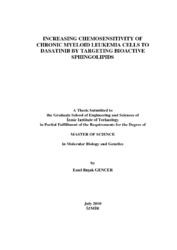Please use this identifier to cite or link to this item:
https://hdl.handle.net/11147/3053Full metadata record
| DC Field | Value | Language |
|---|---|---|
| dc.contributor.advisor | Baran, Yusuf | - |
| dc.contributor.author | Gencer, Emel Başak | - |
| dc.date.accessioned | 2014-07-22T13:50:48Z | - |
| dc.date.available | 2014-07-22T13:50:48Z | - |
| dc.date.issued | 2010 | - |
| dc.identifier.uri | http://hdl.handle.net/11147/3053 | - |
| dc.description | Thesis (Master)--Izmir Institute of Technology, Molecular Biology and Genetics, Izmir, 2010 | en_US |
| dc.description | Includes bibliographical references (leaves: 56-68) | en_US |
| dc.description | Text in English; Abstract: Turkish and English | en_US |
| dc.description | xii, 68 leaves | en_US |
| dc.description.abstract | Sphingolipids are bioeffector molecules which control various aspects of cell growth, proliferation, apoptosis, senescence, and drug resistance. Ceramides, the central molecule of sphingolipid metabolism, are inducer of apoptosis and inhibitors of proliferation. Sphingosine-1-phosphate (S1P) and glucosyl ceramide, converted from ceramides by sphingosine kinase-1 (SK1) and glucosyl ceramide synthase (GCS) enzymes respectively, inhibit apoptosis, induce cell proliferation and develop resistance to chemotherapeutic drugs. In this study, we examined the therapeutic potentials of bioactive sphingolipids in chronic myeloid leukemia (CML) by itself and in combination with dasatinib in addition to investigate the roles of ceramide metabolising genes in dasatinib induced apoptosis. Our results demonstrated that application of ceramide analogs and inhibitors of ceramide clearance enzymes decreased cell proliferation and induced apoptosis. On the other hand, targeting bioactive sphingolipids towards generation/accumulation of ceramides increased apoptotic effects of dasatinib synergistically. It was also shown for the first time by this study that dasatinib induces apoptosis through downregulating expression levels of GCS, and SK-1 genes and upregulating expression levels of LASS1, -2, -4, -5, and -6 in K562 cells. However, in Meg-01 cells, dasatinib downregulates expression levels of apoptotic LASS genes. Increasing endogenous ceramides through exogenous ceramide analogues or mimetics and decreasing prosurvival lipids, S1P and GC, can open the way of more effective treatment of CML. | en_US |
| dc.language.iso | en | en_US |
| dc.publisher | Izmir Institute of Technology | en_US |
| dc.rights | info:eu-repo/semantics/openAccess | en_US |
| dc.subject.lcsh | Chronic myeloid leukemia--Molecular aspects | en |
| dc.title | Increasing Chemosensitivity of Chronic Myeloid Leukemia Cells To Dasatinib by Targeting Bioactive Sphingolipids | en_US |
| dc.type | Master Thesis | en_US |
| dc.institutionauthor | Gencer, Emel Başak | - |
| dc.department | Thesis (Master)--İzmir Institute of Technology, Molecular Biology and Genetics | en_US |
| dc.relation.publicationcategory | Tez | en_US |
| dc.identifier.wosquality | N/A | - |
| dc.identifier.scopusquality | N/A | - |
| item.openairecristype | http://purl.org/coar/resource_type/c_18cf | - |
| item.openairetype | Master Thesis | - |
| item.languageiso639-1 | en | - |
| item.cerifentitytype | Publications | - |
| item.grantfulltext | open | - |
| item.fulltext | With Fulltext | - |
| Appears in Collections: | Master Degree / Yüksek Lisans Tezleri | |
Files in This Item:
| File | Description | Size | Format | |
|---|---|---|---|---|
| T000205.pdf | MasterThesis | 1.48 MB | Adobe PDF |  View/Open |
CORE Recommender
Page view(s)
236
checked on May 12, 2025
Download(s)
92
checked on May 12, 2025
Google ScholarTM
Check
Items in GCRIS Repository are protected by copyright, with all rights reserved, unless otherwise indicated.